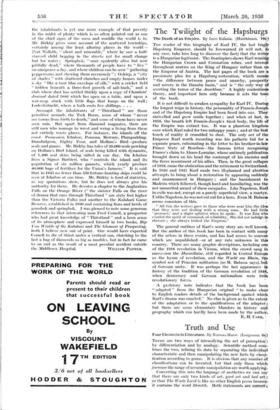News from a D, sort
Thirstland Treks. By Carel Birkby. (Faber. I8s.)
. •
" TIIIRSTLAND " is a fancy name for the region that c'omprises Namaqualand, Bushmanland, the Kalahari Desert, and the coast of South West Africa, and Mr. Birkby is a South African journalist. He reminds us a little too forcibly of what a highly-equipped writer might have done ' with his opportunities, for his book, which seems to consist of un. retouched newspaper articles, is feebly introduced by Colonel Reitz, written in a wretchedly slipshod and often facetious journalese, put together anyhow, illustrated with indifferent photographs, and very expensive at its price. Nevertheless a reader with patience and curiosity will find that Mr. Birkby has not been able to obscure entirely a good deal of interesting information which cannot have been collected without time and trouble, and when he allows facts to speak for themselves they speak eloquently enough.
South West Africa is of course a region- of great mineral wealth. Besides diamonds and copper, which have been responsible for the principal 1:003:715 and slumps in the history of that part of the world, there are deposits of gold, platinum, beryllium, tantalite, monazite, tungsten, bismuth, corundum, columbite, pickeringite, amethysts, tourmalines, and no doubt other interesting substances besides. Mr. Birkby has some remarkable diamond stories, as of the two labourers who, a few years ago,
turned over a boulder under which lay about a bucketful of pebbles. The pebbles were washed and sorted, and from them were taken no less than half a million pounds' worth of diamonds."
The contrast between the diamond fields at Alexander Bay (closely guarded and surrounded with barbed wire, they haVe produced nearly ,five million pounds' worth of the stories in a single year) and the fearful poverty of -many of
the inhabitants is yet one more example of that poverty in the midst of plenty which is so often pointed out as one Of the chief signs of the mess and muddle the world is in. Mr. Birkby gives sonic account of the scattered :townships, certainly among- the least alluring places in the world Port Nolloth, " silent and miserable," where he saw a half- starved child begging in the' streets not for small change but for water ; Springbok, " once opulently alive but now pitifully dead," where thousands of people have to " live " on ninepence a day, and where children can be seen " gathering peppercorns and chewing them ravenously"; Ookiep, a "city of shades " with shuttered churches and empty houses under a sky "like a taut blue envelope of silk," with a cricket field hidden beneath a three-foot growth of salt-bush," and a club where dust has settled thickly upon a copy of Chambers' Journal dated 1886 which lies open on a table, and upon a war-map stuck with little flags that hangs on the wall ; Luderitzbucht, where a bath costs five shillings. . . .
Amongst the inhabitants of " Thirstland " are those primitive nomads the Trek Boers, some of whom "never see towns from birth to death," and some of whom have never seen rain. But apart from diamond magnates, there arc still men who manage to wrest and wring a living from these not entirely waste places. For instance, the islands off the coast —Possession, Ichaboe, Pomona, Mercury, Plumpudding, Dilinfudgeon, Eighty Four, and Holism's Bird—produce seals and guano. Mr. Birkby has tales of 20,000 seals perching on Hollam's Bird Island, of seals being killed with dynamite, of ],400 seal skins being salted in one day. On Ichaboe lives a Signor Barbieri, who " controls the island and its population of six million gannets, which yearly produce 40,000 bags of fertiliser for the Union's farmers." It is said that in 1845 no fewer than 450 fortune-hunting ships could be seen at IchabOc at one time. Mr. Birkby is fond of statistics, as my quotations show, but he does not always give his authority for them. He devotes a chapter to the Aughrabics
• Falls on the Orange River (" the sinister Falls on the river of drama that runs through Thirstland " are sixty feet higher than the Victoria Falls) and another to the Kalahari Game Reserve, established in 1930 and containing lions and herds of gemsbok and springbok. I was pleased to note some generous references to that interesting man Fred Cornell, a prospector who had great knowledge of " Thirstland " and a keen sense of its atmosphere and expressed himself in two books, Rip Ian Winkle of the Kalahari and The Glamour of Prospecting, both I believe now out of print. One would have expected Cornell to die of thirst under a vertical sun, clutching to the last a bag of diamonds as big as marbles, but in fact he came to an end as the result of a most peculiar accident outside



































































 Previous page
Previous page